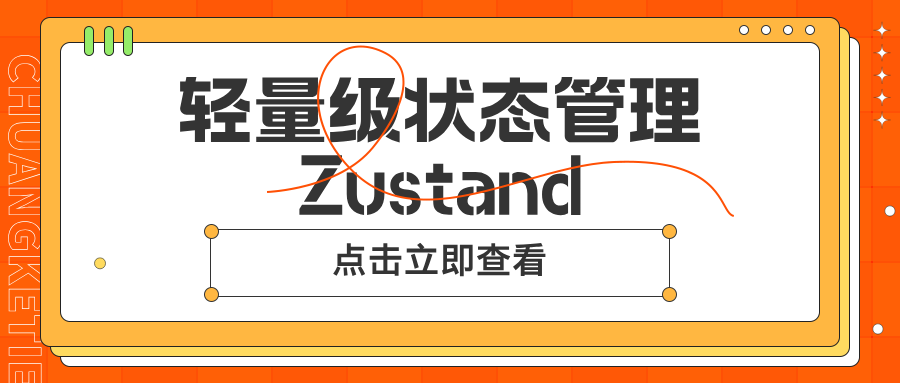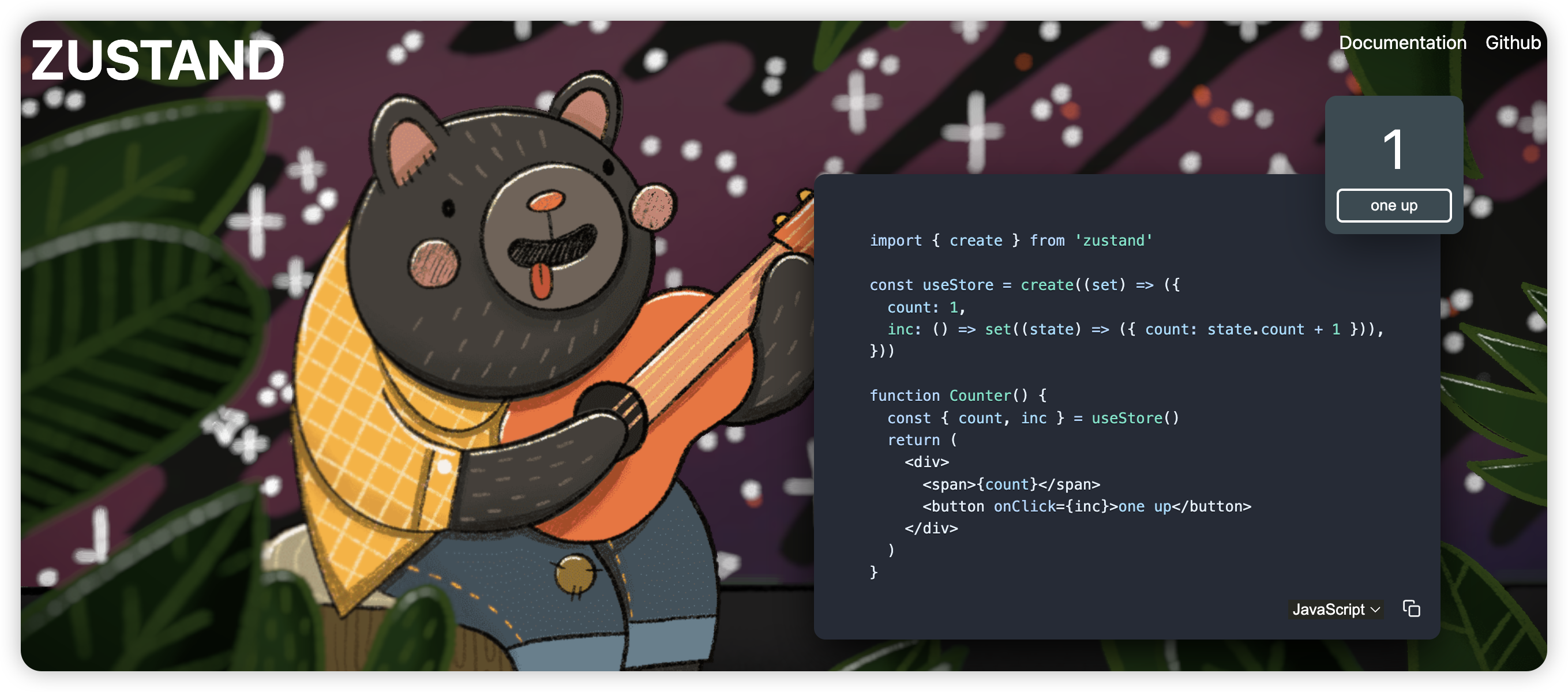zustand状态管理介绍
- Authors
- Name
- 小明&小艺

前言
在前端开发中,状态管理是一个非常重要的话题。我们有很多选择,比如 Redux、MobX、Context API 等等。今天我要向大家介绍一种轻量级但非常强大的状态管理库——Zustand。
一、概念和优势
1.1 什么是 Zustand?

很好看的一个官网。(https://zustand-demo.pmnd.rs/)
Zustand 是一个用于 React 应用程序的状态管理库。它由 Poimandres 团队开发,以其简洁和灵活著称。Zustand 的德语意思是“状态”,它致力于提供一个轻量、简单和强大的解决方案来管理你的应用状态。
1.2 为什么选择 Zustand?
- 轻量且简洁:与 Redux 等复杂的状态管理库相比,Zustand 的 API 简单直观,没有繁重的样板代码。
- 无依赖:Zustand 没有依赖任何其他库,它只是一个纯粹的 JavaScript 库。
- 灵活性:你可以随意使用任何模式来管理状态,Zustand 并不强制你遵循特定的模式。
- 优秀的性能:Zustand 使用不可变数据结构和浅比较来优化性能,确保你的应用运行流畅。
二、如何使用 Zustand
2.1 安装
首先,我们需要安装 Zustand:
npm install zustand
或者使用 Yarn:
yarn add zustand
2.2 创建一个简单的 store
我们可以通过 create 函数来创建一个状态 store。假设我们要管理一个计数器状态:
import create from 'zustand'
const useStore = create((set) => ({
count: 0,
increase: () => set((state) => ({ count: state.count + 1 })),
decrease: () => set((state) => ({ count: state.count - 1 })),
}))
export default useStore
在组件中使用这个 store:
import React from 'react'
import useStore from './store'
function Counter() {
const { count, increase, decrease } = useStore()
return (
<div>
<h1>{count}</h1>
<button onClick={increase}>Increase</button>
<button onClick={decrease}>Decrease</button>
</div>
)
}
export default Counter
2.3 api 介绍
Zustand 提供了一套简洁而强大的 API 来管理应用的状态。下面详细介绍 Zustand 的主要 API 及其用法。
1. create
create 是 Zustand 的核心函数,用于创建一个 store。
import create from 'zustand'
const useStore = create((set) => ({
count: 0,
increase: () => set((state) => ({ count: state.count + 1 })),
decrease: () => set((state) => ({ count: state.count - 1 })),
}))
create 函数接收一个初始化函数作为参数,该函数提供 set 和 get 方法用于更新和获取状态。
2. set
set 方法用于更新状态。它接收一个部分状态对象或者一个状态更新函数。状态更新函数接收当前状态并返回新的部分状态对象。
const useStore = create((set) => ({
count: 0,
increase: () => set((state) => ({ count: state.count + 1 })),
decrease: () => set((state) => ({ count: state.count - 1 })),
}))
3. get
get 方法用于获取当前状态。可以在状态更新函数内部使用 get 方法来读取当前状态。
const useStore = create((set, get) => ({
count: 0,
increase: () => set(() => ({ count: get().count + 1 })),
decrease: () => set(() => ({ count: get().count - 1 })),
}))
4. subscribe
subscribe 方法允许你订阅状态的变化。当状态发生变化时,订阅的回调函数会被调用。
const useStore = create((set) => ({
count: 0,
increase: () => set((state) => ({ count: state.count + 1 })),
}))
const unsubscribe = useStore.subscribe(
(state) => state.count,
(count) => console.log('Count changed to', count)
)
// 取消订阅
unsubscribe()
5. destroy
destroy 方法用于销毁 store,清除所有订阅。
const useStore = create((set) => ({
count: 0,
increase: () => set((state) => ({ count: state.count + 1 })),
}))
useStore.destroy()
6. setState
setState 方法允许你直接设置状态,而不是通过定义的状态更新函数。通常情况下不推荐直接使用 setState,除非你知道自己在做什么。
const useStore = create((set) => ({
count: 0,
}))
useStore.setState({ count: 10 })
7. getState
getState 方法允许你直接获取当前状态。与 get 方法类似,但 getState 是在 store 上调用的。
const useStore = create((set) => ({
count: 0,
}))
const currentState = useStore.getState()
console.log(currentState.count)
8. useStore Hook
在 React 组件中,你可以通过 useStore Hook 来访问状态和状态更新函数。
import React from 'react'
import useStore from './store'
function Counter() {
const { count, increase, decrease } = useStore()
return (
<div>
<h1>{count}</h1>
<button onClick={increase}>Increase</button>
<button onClick={decrease}>Decrease</button>
</div>
)
}
export default Counter
2.4 应用须知
异步状态更新:你可以在状态更新函数中使用异步操作。例如,获取数据后更新状态:
const useStore = create((set) => ({ data: null, fetchData: async () => { const response = await fetch('https://api.example.com/data') const data = await response.json() set({ data }) }, }))中间件:Zustand 支持使用中间件来扩展其功能。例如,使用
redux中间件:import { createStore, applyMiddleware } from 'redux' import { createStore as createZustandStore } from 'zustand' import { redux } from 'zustand/middleware' const store = createZustandStore(redux(reducer, initialState, applyMiddleware(logger)))状态持久化:可以使用中间件将状态持久化到
localStorage或sessionStorage。例如,使用zustand/middleware提供的persist中间件:import create from 'zustand' import { persist } from 'zustand/middleware' const useStore = create( persist( (set) => ({ count: 0, increase: () => set((state) => ({ count: state.count + 1 })), decrease: () => set((state) => ({ count: state.count - 1 })), }), { name: 'count-storage', // 存储的键名 } ) )开发工具支持:Zustand 提供了与 Redux DevTools 兼容的中间件,可以方便地调试状态变化。
import create from 'zustand' import { devtools } from 'zustand/middleware' const useStore = create( devtools((set) => ({ count: 0, increase: () => set((state) => ({ count: state.count + 1 })), decrease: () => set((state) => ({ count: state.count - 1 })), })) )
2.5 实际应用中的注意事项
在实际开发中使用 Zustand 时,有一些注意事项和最佳实践可以帮助你更高效地管理状态,并避免常见的陷阱。下面列举了这些注意事项。
- 避免将所有状态放在一个大 store 中
将所有状态放在一个大 store 中会导致状态管理变得复杂,难以维护和调试。建议将状态拆分成多个小的 store,根据不同的功能模块来管理各自的状态。
import create from 'zustand'
const useUserStore = create((set) => ({
user: null,
setUser: (user) => set({ user }),
}))
const useSettingsStore = create((set) => ({
theme: 'light',
setTheme: (theme) => set({ theme }),
}))
- 为状态提供合理的默认值
在初始化状态时,确保为所有状态属性提供合理的默认值。这有助于避免因状态未初始化而引起的错误。
const useStore = create((set) => ({
user: null,
theme: 'light',
count: 0,
}))
- 避免不必要的状态变化
避免频繁或不必要的状态变化,以减少组件的重新渲染次数。可以通过浅比较优化状态更新。
const useStore = create((set) => ({
count: 0,
increase: () =>
set((state) => {
if (state.count < 10) {
return { count: state.count + 1 }
}
}),
}))
- 利用 TypeScript 提高代码可靠性
使用 TypeScript 可以提高代码的可靠性和可维护性。为 Zustand 的 store 和状态定义类型,有助于避免类型错误。
import create from 'zustand'
interface State {
count: number
increase: () => void
decrease: () => void
}
const useStore = create<State>((set) => ({
count: 0,
increase: () => set((state) => ({ count: state.count + 1 })),
decrease: () => set((state) => ({ count: state.count - 1 })),
}))
- 选择器优化状态读取
使用选择器可以优化状态读取,避免组件重新渲染。选择器可以精确地订阅状态的某一部分变化。
const useStore = create((set) => ({
count: 0,
increase: () => set((state) => ({ count: state.count + 1 })),
decrease: () => set((state) => ({ count: state.count - 1 })),
}))
const useCount = () => useStore((state) => state.count)
function Counter() {
const count = useCount()
const increase = useStore((state) => state.increase)
const decrease = useStore((state) => state.decrease)
return (
<div>
<h1>{count}</h1>
<button onClick={increase}>Increase</button>
<button onClick={decrease}>Decrease</button>
</div>
)
}
在实际开发中使用 Zustand 需要注意状态的拆分与模块化、状态初始化与默认值、异步操作与状态更新、性能优化、状态持久化、调试与开发工具的使用、以及结合 TypeScript 和选择器来提高代码的可靠性和可维护性。通过遵循这些注意事项和最佳实践,可以更高效地管理 React 应用中的状态。
三、Zustand 的核心原理
Zustand 的核心是通过 create 函数创建一个 store。create 函数接收一个初始化函数,该函数使用 set 和 get 方法来定义状态和操作。状态的更新是通过 set 函数完成的,而 get 函数允许在状态更新函数中获取当前状态。
3.1 不可变数据结构
Zustand 使用不可变数据结构,这意味着状态更新不会直接修改现有状态,而是创建一个新的状态对象。这有助于避免副作用并确保状态变化的可预测性。
3.2 浅比较优化
为了优化性能,Zustand 在状态更新时使用浅比较。这意味着只有当状态对象的顶级属性发生变化时,组件才会重新渲染。这减少了不必要的重新渲染,提高了应用的性能。
四、结合 Next.js 使用
在 Next.js 中使用 Zustand 需要考虑到服务器端渲染(SSR)和客户端渲染(CSR)之间的区别。
客户端渲染
在客户端渲染中使用 Zustand 非常简单,直接在组件中使用 Zustand 创建的 store 即可。
服务器端渲染
在服务器端渲染中,你需要确保每个请求都使用独立的 Zustand store。可以使用 getServerSideProps 或 getStaticProps 函数来初始化状态,并在客户端使用同一个状态。
import create from 'zustand'
const useStore = create((set) => ({
count: 0,
increase: () => set((state) => ({ count: state.count + 1 })),
decrease: () => set((state) => ({ count: state.count - 1 })),
}))
export const getServerSideProps = async () => {
const store = useStore.getState()
return {
props: {
initialState: store,
},
}
}
export default function Page({ initialState }) {
const { count, increase, decrease } = useStore()
return (
<div>
<h1>{count}</h1>
<button onClick={increase}>Increase</button>
<button onClick={decrease}>Decrease</button>
</div>
)
}
结论
Zustand 是一个强大且灵活的状态管理库,适用于各种规模的 React 应用程序。通过理解其核心原理和插件机制,可以更好地利用 Zustand 提高开发效率和代码质量。无论是单纯的客户端渲染,还是复杂的服务器端渲染应用,Zustand 都能提供一个简洁且高效的解决方案。